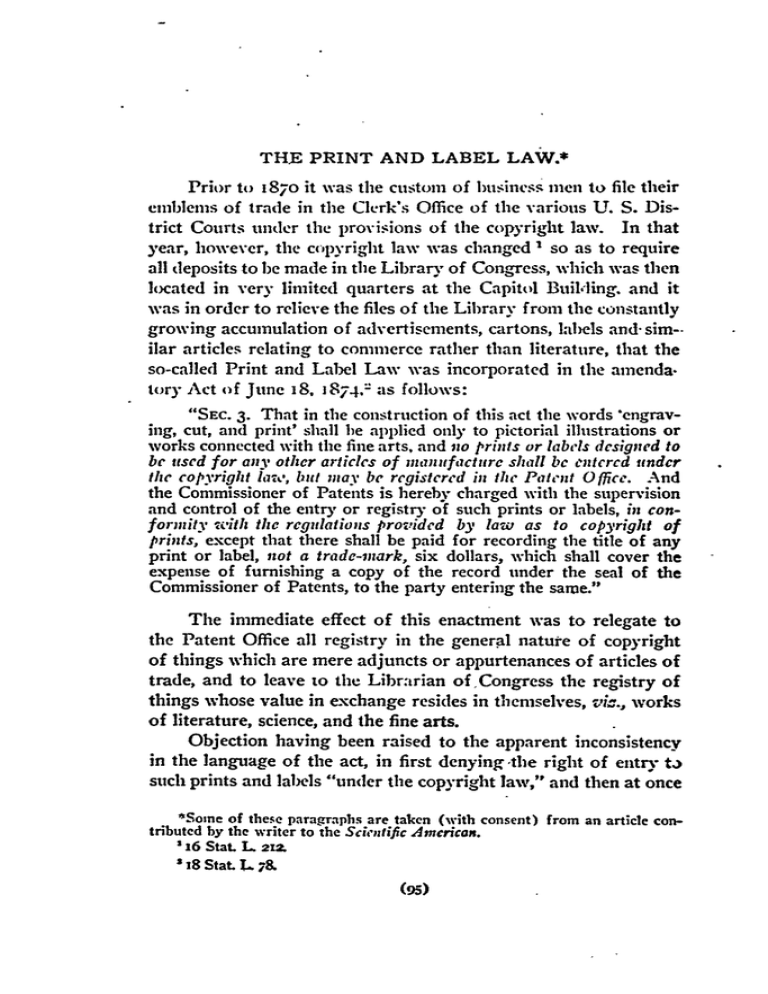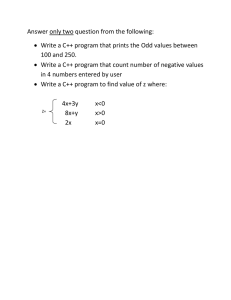The Print and Label Law - Penn Law: Legal Scholarship Repository
advertisement

THE PRINT AND LABEL LAW.* Prior to 187o it was the custom of business men to file their emblems of trade in the Clerk's Office of the various U. S. District Courts under the provisions of the copyright law. In that year, however, the copyright law was changed I so as to require all deposits to be made in the Library of Congress, which was then located in very limited quarters at the Capitol Building and it was in order to relieve the files of the Library from the constantly growing accumulation of advertisements, cartons, labels and- sim-ilar articles relating to commerce rather than literature, that the so-called Print and Label Law was incorporated in the amenda. tory Act of June 18. 1874.* as follows: "SEc. 3. That in the construction of this act the words "engraving, cut, and print' shall be applied only to pictorial illustrations or works connected with the fine arts, and no prints or labels designed to be used for any other articles of manufacture shall be entcrcd undcr the copyright lawo, but may be registered in the Patent Office. And the Commissioner of Patents is hereby charged with the supervision and control of the entry or registry of such prints or labels, in conformity with the regulations provided by law as to copyright of prints, except that there shall be paid for recording the title of any print or label, not a trade-mark, six dollars, which shall cover the expense of furnishing a copy of the record under the seal of the Commissioner of Patents, to the party entering the same." The immediate effect of this enactment was to relegate to the Patent Office all registry in the general nature of copyright of things which are mere adjuncts or appurtenances of articles of trade, and to leave to the Librarian of Congress the registry of things whose value in exchange resides in themselves, vio., works of literature, science, and the fine arts. Objection having been raised to the apparent inconsistency in the language of the act, in first denying the right of entry ta such prints and labels "under the copyright law," and then at once *Some of these paragraphs are taken (with consent) from an article contributed by the writer to the Scientific Amcricax. 216 Stat. L 21Z. S 18 Stat. L . UNIVERSITY OF PENNSYLVANIA. LAIV REVIEW 96 requiring the Patent Office to enter them "in conformity with the requirements provided by law as to copyright of prints," the Commissioner ruled in Ex partc Heinz 3 that the clause was to be regarded as commensurate in meaning with: "no prints or labels . shall be entered as provided in the copyright law [i. e., at Copyright Office in the Library of Congress], but may be registered in the Patent Office." The copyright is secured when the registration is complete and a certificate of the registration is given by the Commissioner; just as under the previous law it was secured when the proper filing had been made with the Librarian of Congress and his certificate was issued,' and the statutory provisions which confer the rights and regulate the remedies are those which are contained in the copyright statutes. 5 When the present copyright Code was enacted in i9o9,6 differing views prevailed in official circles as to its probable effect upon the Print and Label Law, but the Attorney General, to whom the question was finally submitted for a formal opinion, decided that the new act did not repeal that part of the old act (as quoted above) which relates to the registration of prints and labels in the Patent Office, and that it was still the duty of the Commissioner to register them in the same manner as before.7 Until, therefore, higher authority decides otherwise, it remains for the Patent Office to administer the Print and Label Law in conformity with the general copyright law, the foundation of which is the clause in the Constitution empowering Congress "To promote the progress of science and useful arts by .securing for limited times to authors and inventors the exclusive right to their respective writings and inventions. 's The Supreme Court has declared that the writings which may be protected by copyright must be original and the fruits of intellectual labor embodied in the form of books, prints, engrav62 Off. Gaz. w64. 'Higgins v. Keuffel, i4o U. S. 428 (i89o). ' March v. Warren, 14 Blatch. 263, Fed. Cas. No. 9 2t. Stat. L ios. '19o9, 28 Op. Att'y Gen. 116; reconsidered and approved by Attorney General M|cReynolds, 1914, 2o3 Off. Gaz. 6oz 635 'Article I, Sec. 8, CL 8. THE PRINT AND LABEL LAW " ings and other forms by which the ideas in the mind of the author or artist are given visible expression.' In Higgins v. Keuffel, supra, the-court denied copyright to a label consisting merely of the name "Waterproof Drawing Ink" in an oblong formed.of double lines and observed that, "To be entitled to a copyright the article must have by itself some value as a composition, at least to the extent of serving some purpose other than as a mere advertisement or designation of the subject to which it is attached." It is well established, however, that the special adaptation of pictorial works to advertising purposes is no bar to copyright. "A picture," said Mr. Justice Holmes in Bleistein v. Donaldson, 0 "is none the less a picture and none the less a subject of copyright that it is used for an advertisement." Courts do not undertake to assume the function of critics, nor to measure carefully the degree of originality or intellectual skill required, but will protect almost every product of literary or artistic labor evincing in its makeup that there has been underneath it, in some substantial way, the mind of a creator or originator.1 1 The rule seems to be that if the article has enough merit and value to be the object of infringement, it is rightly to be deemed of sufficient importance to be entitled to protection.12 In addition to these fundamental requisites of originality and artistic quality, prints and labels must also qualify under the rules of interpretation evolved by the Patent Office. For many years the Office construed the word "print" as being synonymous with "label" and required that the label must-be free from any feature or device capable of sequestration as a trade-mark. But a more liberal rule now prevails. It is recognized that a label stands on a different footing from a print in that it is affixed to the goods, while the print must be separate from the thing it portrays or advertises. If either device has some artistic quality and indicates 'Trade-Mark Cases, ioo U. S. 82 (1879); Burrow-Giles Co. v. Sarony, III U. S. 3 (1883). 0188 U. S. 239 (1go2). "National Tel. v. Western Union, 119 Fed. 294. 2 White Mfg. Co. v. Shapiro, 227 Fed. 957. (A UNIVERSITY OF PENNSYLVANIA LAIV REVIEIV (pictorially or otherwise) the article or contents of the article for which it is used, it is deemed registrable for. copyright protection, regardless of the fact that it may include trade-mark features as 13 well, provided it is not in fact a mere technical trade-i-mark. The print or label must possess just as much artistic quality as would be necessary to entitle it to registration in the Copyright Office if it were not "designed to be used for any other articles of manufacture." 14 The term "other articles of manufacture" is construed to mean articles of merchandise or vendible commodities, substantially as in the trade-mark law. Consequently, a design to be placed on letterheads, cards, etc., as mere ornamentation, and not being itself suggestive of any other article of'manufacture, was denied registration ;15 as was also a print designed to be used as a marker for a highway (see Lincoln Highway case, infra), though the same might be eligible for registration at the Copyright Office if properly characterized as "pictorial illustrations or works connected with"the fine arts." The word "designed," in this connection, does not refer to the state of mind or intention of the author, but to the subjectmatter or quality of the print or label itself, and if that subjectmatter does not suggest or in some manner identify the particular goods for which it is used, the work is not registrable i-1 the Patent Office.16 For if a mere statement of contemplated use by the applicant were permitted to determine whether the alleged print or label should be registered in the Patent Office or in the Copyright Office, the distinction attempted- to be drawn by Congress between the two classes of artistic productions would be piractically nullified."T' In practice, however, a considerable latitude is allowed as to how the print or label shall indicate the goods. A print advertising malt liquors, for example, which included as-an "Ex parle Mahn, 82 Off. Gaz. 1345. 1210; Ex pare ,Vahrman, o4 Off. Gar_ Ex pare Baldwin, 98 Off. Gaz. 17o6; Ex parte Palmer, s8 Off. Gaz. 383. sE.r pare Royal Med. Co., zoo Off. Gaz. 2775. 's Ex parte Taylr, 256 Off. Gaz. 451; Ex pare Mahn, supra; Ex parte Wickert, go Off. Gaz. 1r12. " Ex parte.Regina Music Box Co., zoo Off. Gaz. 2327. 1 TIlE PRINT AND LBEL LAV essential feature the representation of a beer keg, was held sufficient to come within the rules.' 8 The Commissioner must determine for himself whether or not the work presented is registrable as a print or label, and his decision, even though erroneous, cannot be reviewed by mandamus proceedings.10 But no nice application of rules will be made in the Patent Office to determine the degree of artistic quality displayed by the print or label; it will be registered as a matter of course when recpgnized to be of a character which is commonly regarded as the result of artistic or intellectual effort, or which might properly be so regarded. Registration will only be refused if the article belongs to that class which is not intended for the production of artistic effect on the beholder, and which does not in fact produce any; as where the label consists only of printed text, with directions for use of the contents of the box or bottle to which it is applied.20 Where, however, the work is intended to be used to further any unlawful enterprise, such as a lottery scheme or game of chance, the Patent Office very properly holds that even if it would not be against the letter of the law to register, it would be against public policy to do so. One executive department of the government should not be expected to give aid and encouragement to anything which it would be the duty of another branch of the government to suppress. 2 1 So also the Office will refuse to give its approval to the use of the flag or other public insignia of this or any foreign nation as an advertising device, by registering a print or label embodying such flag or insignia. 22 On the basis of the foregoing principles, the present rules of the Patent Office define a print as "an artistic and intellectual production designed to be used for an article of manufacture, and Ex parle Ruppert, 12! Off. Gaz. 2327. 'U. S. ex rel. Lincoln Highway Assn. v. Ewing, 42 D. C. App. 5o8; Allen v. U. S. ex tel., Regina Music Box Co., 22 D. C. App. 271, reversing the lower 2 court. Ex parte Howe & Son, 123 Off. Gaz. v.283; Ex parte Houghton, 99 Off. Gaz. z623 a Ex pare Allen & Co., 156 Off. Gaz. io65. Ex parte Biddle Co., 2-6 Off. Gaz. 8z; Ex parte Ball, 98 Off. Ga=. 2366. Too UNIVERSITY OF PENNSYLVANIA LAW REVIEW in some fashion pertaining thereto, but not borne by it; such, for instance, as an advertisement thereof"; and a label as "an artistic and intellectual production impressed or stamped directly upon the article of manufacture, or upon a slip or piece of paper or other material to be attached in any manner to manufactured articles, or to bottles, boxes, and packages containing them, to indicate the article of manufacture." No print or label can be registered unless it properly belongs to an article of manufacture and is descriptive thereof, and is as above defined; but no exam3 ination will be made as to its novelty. Herbert A. Howell. Washington, D. C. 'Rules 21, 28. 29 and 30. in the pamphlet "United States Statutes concerning the Registration of Prints and Labels, with the rules of the .Patent Office relating thereto"; edition of August 15, i913; reprinted 199.

